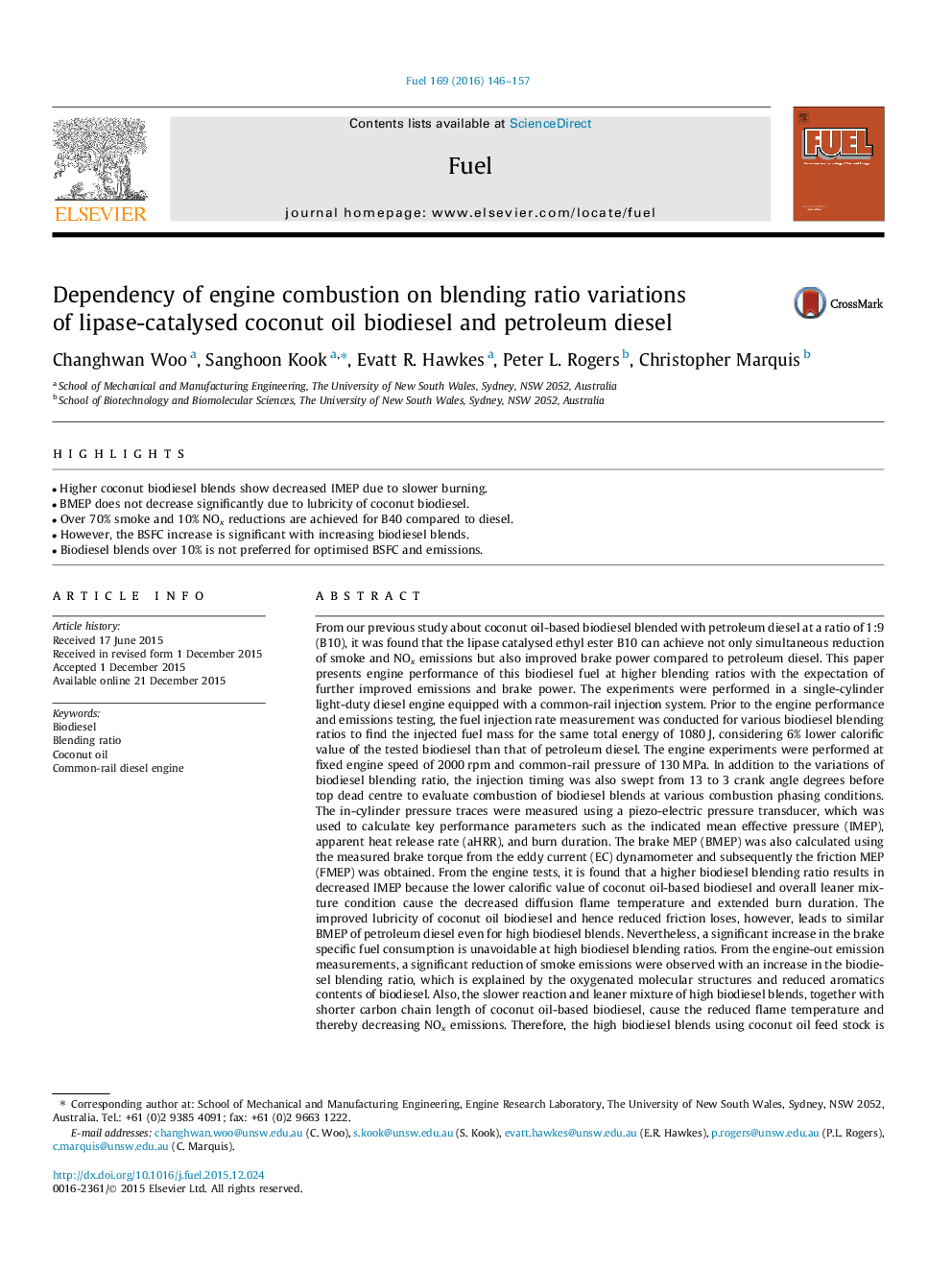| کد مقاله | کد نشریه | سال انتشار | مقاله انگلیسی | نسخه تمام متن |
|---|---|---|---|---|
| 205323 | 461104 | 2016 | 12 صفحه PDF | دانلود رایگان |
• Higher coconut biodiesel blends show decreased IMEP due to slower burning.
• BMEP does not decrease significantly due to lubricity of coconut biodiesel.
• Over 70% smoke and 10% NOx reductions are achieved for B40 compared to diesel.
• However, the BSFC increase is significant with increasing biodiesel blends.
• Biodiesel blends over 10% is not preferred for optimised BSFC and emissions.
From our previous study about coconut oil-based biodiesel blended with petroleum diesel at a ratio of 1:9 (B10), it was found that the lipase catalysed ethyl ester B10 can achieve not only simultaneous reduction of smoke and NOx emissions but also improved brake power compared to petroleum diesel. This paper presents engine performance of this biodiesel fuel at higher blending ratios with the expectation of further improved emissions and brake power. The experiments were performed in a single-cylinder light-duty diesel engine equipped with a common-rail injection system. Prior to the engine performance and emissions testing, the fuel injection rate measurement was conducted for various biodiesel blending ratios to find the injected fuel mass for the same total energy of 1080 J, considering 6% lower calorific value of the tested biodiesel than that of petroleum diesel. The engine experiments were performed at fixed engine speed of 2000 rpm and common-rail pressure of 130 MPa. In addition to the variations of biodiesel blending ratio, the injection timing was also swept from 13 to 3 crank angle degrees before top dead centre to evaluate combustion of biodiesel blends at various combustion phasing conditions. The in-cylinder pressure traces were measured using a piezo-electric pressure transducer, which was used to calculate key performance parameters such as the indicated mean effective pressure (IMEP), apparent heat release rate (aHRR), and burn duration. The brake MEP (BMEP) was also calculated using the measured brake torque from the eddy current (EC) dynamometer and subsequently the friction MEP (FMEP) was obtained. From the engine tests, it is found that a higher biodiesel blending ratio results in decreased IMEP because the lower calorific value of coconut oil-based biodiesel and overall leaner mixture condition cause the decreased diffusion flame temperature and extended burn duration. The improved lubricity of coconut oil biodiesel and hence reduced friction loses, however, leads to similar BMEP of petroleum diesel even for high biodiesel blends. Nevertheless, a significant increase in the brake specific fuel consumption is unavoidable at high biodiesel blending ratios. From the engine-out emission measurements, a significant reduction of smoke emissions were observed with an increase in the biodiesel blending ratio, which is explained by the oxygenated molecular structures and reduced aromatics contents of biodiesel. Also, the slower reaction and leaner mixture of high biodiesel blends, together with shorter carbon chain length of coconut oil-based biodiesel, cause the reduced flame temperature and thereby decreasing NOx emissions. Therefore, the high biodiesel blends using coconut oil feed stock is very promising to overcome the smoke–NOx trade-off of petroleum diesel. When both the brake specific fuel consumption and smoke/NOx emissions are considered, however, the optimised biodiesel blending ratio of the tested conditions of this study is found at low B10.
Journal: Fuel - Volume 169, 1 April 2016, Pages 146–157
